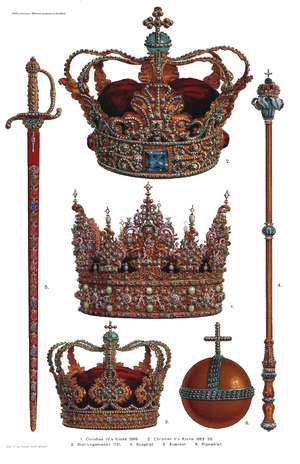
Back Dánské korunovační klenoty Czech De danske kronregalier Danish Dänische Kronjuwelen German Joyaux de la Couronne danoise French Gioielli della Corona danese Italian Danmarks kronregalier NB Joias da Coroa Dinamarquesa Portuguese Danmarks riksregalier Swedish Регалії данської корони Ukrainian
This article needs additional citations for verification. (August 2009) |

Danish Crown Regalia are the symbols of the Danish monarchy. They consist of three crowns, a sceptre (symbolizing supreme authority), globus cruciger (an orb symbolizing the earthly realm surmounted by a cross), the sword of state and an ampulla (symbolizing anointing of monarchs). The Danish Royal Regalia are kept in the treasury at Rosenborg Castle. The oldest of these is Christian III's sword of state from 1551. They further include King Christian IV's diamond; pearl- and gold-embroidered saddles; objects carved from ivory and rock-crystal; lapidary pieces of precious stones, and brooches in the form of fantastic animals. [1]
During the time of the elective monarchs, the clergy and nobility placed the crown on the king's head at the coronation ceremony. After the introduction of absolutism in 1660, the crowning of the king was replaced by anointment, for which the king arrived in the church wearing the crown and was consecrated to his calling by being anointed with oil. For the anointing of Christian V, a new crown was made along with the Throne Chair of Denmark of narwhal teeth (supposedly the mythical unicorn's horn) and three silver lions, the latter created by Ferdinand Küblich (1664–1687). This was inspired by the biblical description of King Solomon's throne, which was said to be composed of unicorn's horn and gold and guarded by twelve golden lions.[2]
With the 1849 Constitution, anointing was discontinued and since then the regalia have only been used on the occasion of a deceased monarch's Castrum doloris ('camp of woe') where the crown is placed on the coffin, the other regalia laid at casket's foot, and the casket surrounded by the three lions. The lions were formerly also displayed in Parliament during the annual opening session, but this tradition was discontinued almost 100 years ago. They were also displayed before the throne in the throne room of Christiansborg Palace when the Danish kings granted audiences on particularly formal occasions.[3]
The crown jewels refer to four sets (parures) of jewellery owned by the state for an incumbent queen and, at least until the point of her abdication, still worn by the Margrethe II as Queen of Denmark.[4]
The royal regalia, which symbolised the monarch's authority to rule, includes the crown of King Christian IV, which is a fine example of Renaissance guildwork, the better known crown of King Christian V and a smaller crown for the king's consort. The Royal Collection has other important items and jewels, as well as precious prayer-books, and items belonging to the Order of the Elephant and the Order of the Dannebrog (such as the large diamond and pearl star of the Order of the Elephant worn on the coronation mantle).
- ^ "Danmarks kongekroner og herskersymboler". Rosenborg. Retrieved September 1, 2016.
- ^ "Ferdinand Küblich". Weilbachs Kunstnerleksikon. Retrieved September 1, 2016.
- ^ Such as when in 1905 Christian IX accepted on behalf of his grandson, Carl, the Norwegian parliament's offer of the throne of Norway.
- ^ "The Crown Jewels - The Royal Danish Collection". The Royal Danish Collection.